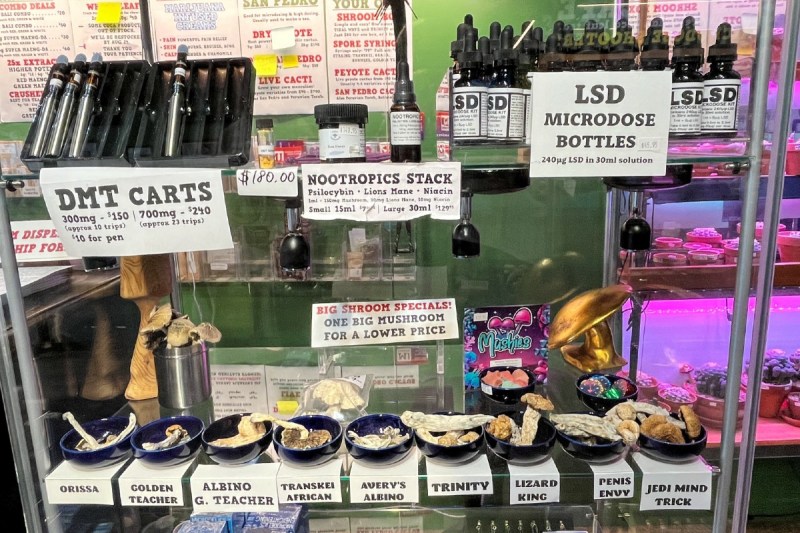
The world of psychedelic drugs has grown way beyond the magic mushrooms previous generations used to take at Grateful Dead concerts. It has grown and expanded in many ways, including DMT, a powerful drug that has come on the scene.
So what is DMT? I recently gave it a try. The instructions were simple: Inhale from the vape for three sustained pulls — while seated. That last bit is crucial because it doesn’t seem like your body is capable of much — standing included — when DMT is on the scene. Come to think of it, I have no idea what your body is doing when you’re smoking DMT because after I took the third pull, I’m pretty sure I went somewhere else. I’m also pretty sure that my body stayed behind, more or less collapsed on the couch of my Vancouver Airbnb.
What is the DMT trip like? Are there any risks? One thing is sure: DMT is a drug that’s a class of psychedelic all on its own.

What is DMT?
To dig into the finer details of what, exactly, DMT is, I corresponded with Dr. Steven A. Barker of Louisiana State University, who has spent the past 45 years researching DMT.
“DMT is a member of the psychedelic indole-alkyl-amine alkaloids such as LSD (synthetic), psilocybin, bufotenine, and 5-methoxy-DMT (all naturally occurring). The N,N-dimethyl tryptamine skeleton is common to all of these hallucinogens,” he explained. “DMT is found in many plants, as well as animals, including humans, and the internet is replete with methods for DMT extraction and isolation from a variety of plant sources.”
He went on to describe how the drug DMT, meaning N,N-dimethyltryptamine, has “botanical roots and an archaic cultural history of use for magic, medicine, and religious ritual” purposes. Most commonly known as the key psychoactive substance in ayahuasca, it is used in “shamanistic ritual, as historically practiced among aboriginal peoples for curing, divination, diagnosis of the imbalances of the body and soul and as a ready pharmacological path to the mythological supernatural.” In other words, it is associated with its ability to “treat and intervene in physical, emotional, psychological, and spiritual conditions.”
Is it the same thing as ayahuasca?
Yes and no. While DMT is the primary psychotropic ingredient in ayahuasca, “Mother Aya” also includes an MAOI substance that prevents your body from breaking down DMT rapidly. This results in a much longer experience, and sometimes much stronger.

What is the DMT experience like?
Now let’s get down to brass tacks: What does this stuff do to you?
First, you need to understand that DMT drugs are primarily consumed in one of two forms: It’s either a powder that is smoked or vaped, or it’s combined with a secondary compound called an MAOI inhibitor to create the concoction ayahuasca. These impart two very different experiences.
I have participated in two ayahuasca ceremonies. In the first, I didn’t take enough, and though I did not have quite the cosmic experience that my companions did, I still did experience a degree of disassociation and the feeling that my consciousness was traveling through a far-off reach of space. The next time, I took a considerably stronger dose and spent some amount of time following a psychic tunnel through the universe that carried me to something akin to nonduality — oneness with everything. On the way there, I saw and interacted with entities that looked like clouds of light strings. They weren’t in the non-duality —everything was. And when I say everything, I mean everything: Every place, time, thought, identity, whatever. I’m saying that I was everything, everywhere, all at once (which is a great movie, incidentally, and you should see it). Heavy stuff.
Throughout this entire experience, I was aware that my body existed, and sometimes I even used it to do things like walk around, pee, stare into a fire, and — once — puke. This isn’t the case, however, when you smoke pure DMT. In that situation, you say goodbye to your body entirely and go “Someplace Else.”
Where? What do I mean by that? It’s fantastically difficult to explain. Here’s the closest I can approximate it with words.
You enter into a place of endlessly intricate, fractalizing architecture. This place is very convincingly real. There are kaleidoscopic corridors and hallways veering off in every direction that tend to meet at larger rooms or junctions of some kind. To a certain degree, you can travel through this architecture. It’s apparent this Other Space both is and is not in our dimension. It’s more like the crawlspace between dimensions. I know this sounds completely insane, but it’s very convincing. It seems exceedingly real — maybe more real than the normal reality we live in. And just wait — it gets crazier.
There are people there. Entities. The renowned psychedelic researcher Terence McKenna famously referred to them as “machine elves” and “jeweled self-dribbling basketballs.” These descriptors are as good as any. What you call them doesn’t really matter. What matters is that they seem very real.

What are the DMT elves?
In my case, I saw many of these entities, but I can remember directly interacting with only two.
The first was when I initially vaped the DMT and catapulted into the Other Space. There was a glowing, transforming being with a distinctly feminine energy that happened to be passing by when I appeared. The moment she saw me, she pounced on me, hungry and burning and desirous. It wasn’t intended in a malicious way; I got more of a sense that she had been alone there for a very long time and saw in me some kindred spirit. In any case, it freaked me out a little bit, and I sort of withdrew my consciousness. She seemed to recognize my fear — and I was definitely afraid at first because it seemed like this burning lust goddess was trying to devour me whole — and sent these vague thoughts of soothing and explanation toward me. Then she raced off down one of the corridors, seemingly a little embarrassed by the whole incident.
Okay. By then, I had decided that I in fact wanted to get to know her better, but as I tried to follow her, the effects of the drug began to wear off. I reeled back into our reality. Maggot Brain was playing on the stereo. Maybe five minutes had passed. I wanted to go back and find her.
So I took two big pulls from the vape and zoomed back into the Other Space. This time I went to an entirely different corridor, however, where I encountered this kind of slouching, morose being who was skulking down one of the electric crystal hallways like he was in a bad mood. I asked him about the other being and he kind of shrugged and communicated something like It’s a big place, man. I don’t know.
And then again I was back. The entire experience lasted maybe ten minutes — three Funkadelic songs.
So what the hell was all that? It was, as I said, very convincingly real.
According to Dr. Barker, “In the shamanistic tradition, using hallucinogenic plant materials, music, dance, and/or other techniques and rituals, one would often undergo experiences that involved meeting with mythical entities and/or the actual process or the perception of death. This included a journey to a separate reality that was traversed through a tunnel or dark void and the assistance or intercession of spirit helpers and/or animal entities, eventually returning to normal consciousness enlightened by the experience. Thus, the occurrence of McKenna’s ‘elves’ and Strassman’s ‘entities’ are not new phenomena to the experience of consumers of DMT. These entities are usually said to impart knowledge and insight and appear ‘as more real than reality itself.'”
(Writer’s note: See? I told you.)
“They are certainly ‘real’ to the one experiencing such an event. It is of interest that the DMT experience has been shown to be not dissimilar to actual reported near-death experiences, wherein people encountered long-dead relatives and even ‘god,'” Barker continued.

Are there any therapeutic benefits to DMT?
These days, psychedelic therapy is all the rage, but it primarily involves psilocybin mushrooms, ketamine, MDMA, or in some cases LSD, which studies have indicated can be used to treat a range of mental disorders. So is there any beneficial link between DMT and anxiety, depression, PTSD, or the like?
Dr. Barker explained that ayahuasca is most commonly associated with the treatment of a range of conditions, and that “long-term ayahuasca users (greater than 10 years) have shown reduced ratings of hopelessness and marked improvement in depressive symptoms with no concomitant mania or hypomania for up to 21 days after a single dose.”
He does admit that because ayahuasca is a complex mixture containing not just DMT but also MAOIs that are known for their ability to treat depression, it’s difficult to know if this combination delivers its therapeutic effects due to one substance or the other. In any case, he said that “several recent studies using DMT alone, administered IV or through inhalation, have shown significant effects in treating intransigent depression and PTSD.”
He said there is even research suggesting that “DMT is protective during cardiac arrest and perinatal development and may be useful in therapy of hypoxic brain injury and Alzheimer’s disease.” Some researchers have proposed that DMT might be used to treat substance abuse, inflammation, or even cancer.
Dr. Barker does warn that more research is needed before these benefits can be verified and DMT can be wielded in the medical field.

Are there any risks to using DMT?
As with the other major psychedelics, the risks associated with DMT seem to be low.
Most of the negative side effects tend to come during the ayahuasca experience. It can be physically uncomfortable, nauseating, and in some cases can cause severe mental distress (all part of the process). Smoking DMT has very few physical side effects. Your body mostly plops back in its seat and maybe feels a little weird and tingly afterward.
Post-trip, a very small percentage of users have experienced negative mood changes. Psychedelics can trigger psychotic episodes in people with preexisting psychiatric disorders like schizophrenia, so it’s strongly advised that people with these types of conditions avoid psychedelics or use them with extreme caution.
That said, the vast majority of people who try DMT will experience no lasting negative side effects. “Indeed,” Dr. Barker explained, “pharmacological studies of acute ayahuasca administration to healthy volunteers and mental health assessments of long-term ayahuasca consumers suggest that this ethnobotanical medicine is relatively safe.”

Is DMT addictive?
The low risks of DMT use also carry over to the possibility of addiction. According to the Partnership to End Addiction, DMT doesn’t carry the same risk of addiction that exists when using substances like alcohol, nicotine, or opioids. Unlike those other substances, people who stop using DMT generally don’t feel any symptoms of withdrawal as occurs with users of stronger drugs, such as heroin.
However, one effect that can happen with DMT users who use other substances is that those substances can sometimes trigger flashbacks, which could cause anxiety. So, as is the case with any mind-altering substance, always be careful.



